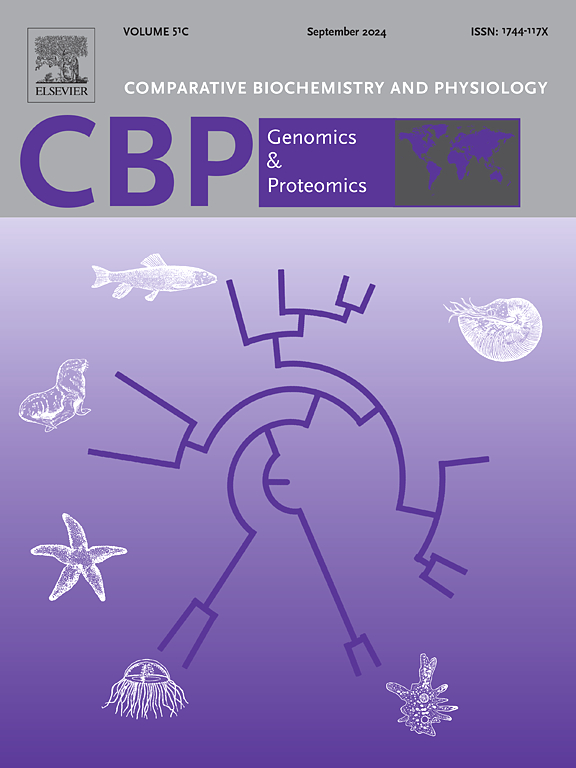Transcriptional landscape of brain adaptation to artificial feed domestication in mandarin fish (Siniperca chuatsi) revealed by weighted gene co-expression network analysis
IF 2.2
2区 生物学
Q4 BIOCHEMISTRY & MOLECULAR BIOLOGY
Comparative Biochemistry and Physiology D-Genomics & Proteomics
Pub Date : 2025-05-21
DOI:10.1016/j.cbd.2025.101543
引用次数: 0
Abstract
Mandarin fish (Siniperca chuatsi) initially reject dead prey or artificial feed, yet their innate feeding behaviors can be modified through training. However, the changes in gene expression in the brain and the associated molecular mechanisms underlying the acquisition of new feeding behaviors in mandarin fish are not well understood. In this study, two groups of mandarin fish were established: one group that was easily domesticated and transitioned from live prey to artificial diets (QN group), and another group that failed to adapt to artificial diets throughout the domestication process (DN group). The results showed that the QN group had significantly greater body weight and length compared to the DN group. Transcriptome analysis identified 811 differentially expressed genes (DEGs), with 393 genes upregulated and 418 downregulated. Functional enrichment analysis revealed significant enrichment in the steroid biosynthesis pathway. Weighted gene co-expression network analysis (WGCNA) identified brown and turquoise modules strongly correlated with high artificial feed intake, containing 1849 genes. KEGG analysis further indicated that the steroid biosynthesis pathway, especially progesterone synthesis, plays a key role in the dietary adaptation process. RT-qPCR and ELISA validation of transcriptome data confirmed the upregulation of progesterone levels, closely associated with food habit domestication. It was therefore speculated that the mandarin fish's ability to consume artificial diets might be attributed to the upregulation of genes associated with steroid biosynthesis, which in turn promotes progestogen synthesis. This study suggested a link between steroid biosynthesis and dietary domestication in animals, potentially revealing a novel molecular mechanism underlying dietary domestication.

加权基因共表达网络分析揭示了鳜鱼脑适应人工饲料驯化的转录格局
鳜鱼(sininiperca chuatsi)最初拒绝死猎物或人工饲料,但它们天生的摄食行为可以通过训练来改变。然而,鳜鱼大脑中基因表达的变化及其获得新摄食行为的相关分子机制尚不清楚。本研究建立了两组鳜鱼:一组是容易驯化的,从活饵料过渡到人工饲料的(QN组),另一组是在整个驯化过程中无法适应人工饲料的(DN组)。结果显示,与DN组相比,QN组的体重和长度显著增加。转录组分析鉴定出811个差异表达基因(DEGs),其中393个基因上调,418个基因下调。功能富集分析显示类固醇生物合成途径显著富集。加权基因共表达网络分析(WGCNA)发现棕色和绿松石色模块与高人工采食量密切相关,包含1849个基因。KEGG分析进一步表明,类固醇生物合成途径,尤其是孕酮合成途径在饲料适应过程中起着关键作用。RT-qPCR和ELISA验证的转录组数据证实,黄体酮水平上调与饮食习惯驯化密切相关。因此,我们推测鳜鱼食用人工饲料的能力可能归因于与类固醇生物合成相关的基因上调,这反过来促进了孕激素的合成。这项研究提示了类固醇生物合成与动物饮食驯化之间的联系,可能揭示了饮食驯化的一种新的分子机制。
本文章由计算机程序翻译,如有差异,请以英文原文为准。
求助全文
约1分钟内获得全文
求助全文
来源期刊
CiteScore
5.10
自引率
3.30%
发文量
69
审稿时长
33 days
期刊介绍:
Comparative Biochemistry & Physiology (CBP) publishes papers in comparative, environmental and evolutionary physiology.
Part D: Genomics and Proteomics (CBPD), focuses on “omics” approaches to physiology, including comparative and functional genomics, metagenomics, transcriptomics, proteomics, metabolomics, and lipidomics. Most studies employ “omics” and/or system biology to test specific hypotheses about molecular and biochemical mechanisms underlying physiological responses to the environment. We encourage papers that address fundamental questions in comparative physiology and biochemistry rather than studies with a focus that is purely technical, methodological or descriptive in nature.

 求助内容:
求助内容: 应助结果提醒方式:
应助结果提醒方式:


